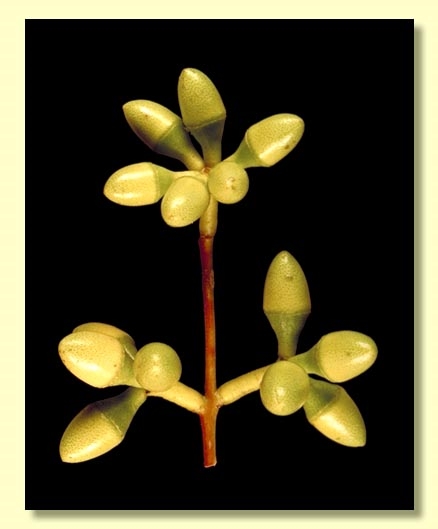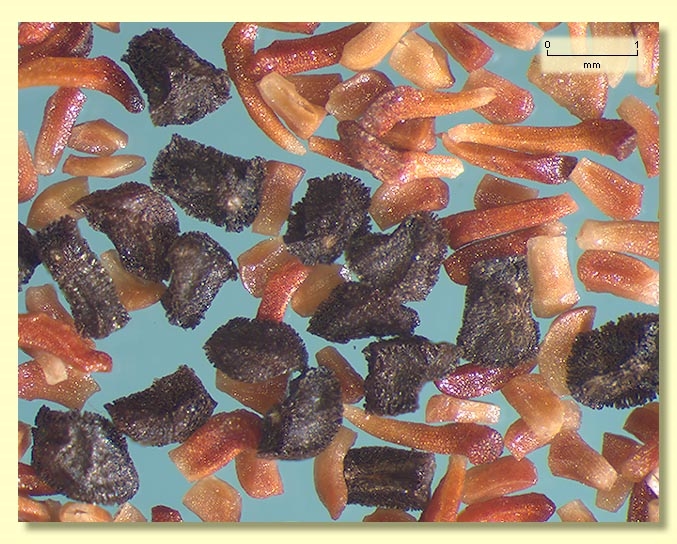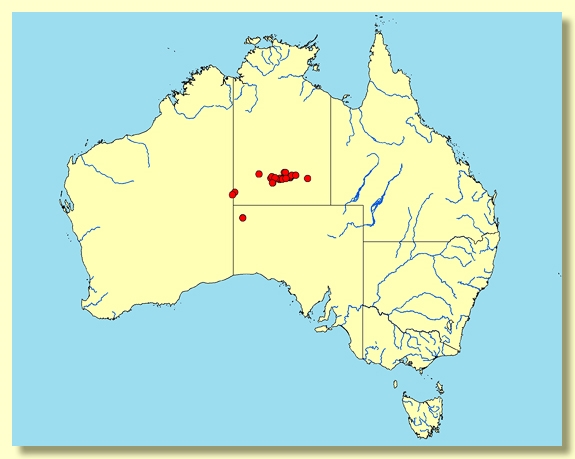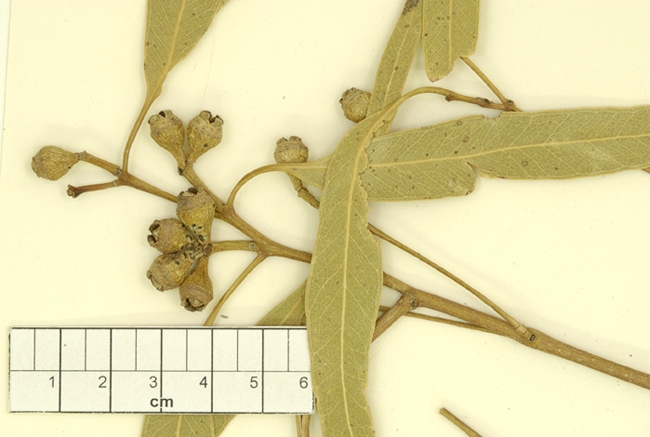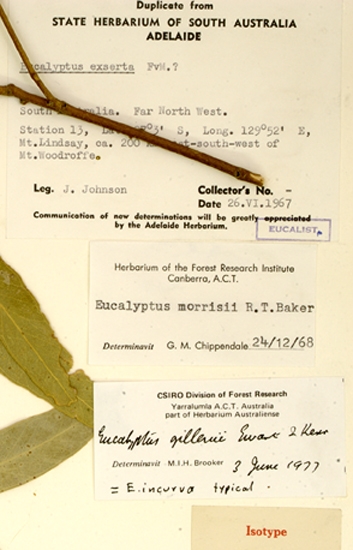Euclid - Online edition
Eucalyptus gillenii
Eucalyptus | Symphyomyrtus | Exsertaria | Erythroxylon
Bark smooth throughout, mottled grey, white, pinkish, and shades of brown.
Branchlets lacking oil glands in the pith.
Juvenile growth (coppice or field seedlings to 50 cm): stems square in cross-section; leaves always petiolate, alternate, narrowly to broadly lanceolate, ca 7–10 cm long, 1–4 cm wide, green to blue-green.
Adult leaves alternate, petiole 0.8–3.3 cm long; blade linear to narrowly lanceolate, 7–18(19) cm long, 0.9–2.6 cm wide, base tapering to petiole, concolorous, dull, blue-green to grey-green to green, side-veins greater than 45° to midrib, moderately to densely reticulate, intramarginal vein remote from margin, oil glands island, numerous.
Inflorescence axillary unbranched, peduncles 0.4–1.3 cm long, buds 7, 9 or ?11, pedicellate (pedicels 0.1–0.4 cm long). Mature buds ovoid (0.7–1.6 cm long, 0.4–0.7 cm wide), scar present (outer operculum shed early), operculum conical to rounded to slightly beaked (0.5–1.2 cm long), stamens mostly erect (a few shorter inner stamens slightly inflexed), anthers oblong, versatile, dorsifixed, dehiscing by lateral slits, style long, stigma blunt to tapered, locules 4 or 5, the placentae each with 6–8 vertical ovule rows. Flowers white.
Fruit sessile or pedicellate (pedicels 0–0.5 cmm long), usually hemispherical to cup-shaped, 0.3–0.9 cm long, 0.6–1.2 cm wide, disc raised steeply, valves 4 or 5, exserted.
Seeds brownish-black, 1–2 mm long, cuboid to pyramidal, dorsal surface variably pitted, hilum terminal.
Cultivated seedling (scored at ca node 10): cotyledons more or less oblong-reniform; stems square in cross-section; leaves always petiolate, opposite for 5 or 6 nodes then alternate, lanceolate, 6–13 cm long, 0.8–3.5 cm wide, dull, green to blue-green to grey-green.
Flowering has been recorded in February, March, April, November and December.
A mallee common on rocky hills in the central and south-western part of central Australia, in the Macdonnell Ranges and Petermann Ranges in the Northern Territory and more rarely in the far north-west of South Australia on the Birksgate Range, and just crossing the border into Western Australia in the Dean Range (also reported from Skirmish Hill). The bark of Eucalyptus gillenii is smooth and the adult leaves dull, blue-green to grey-green to green and the juvenile leaves relatively narrow.
E. gillenii belongs to the group of red gums which is distinguished by having buds with the stamens mostly erect, fruit where the disc is united to the ovary roof and by the black, toothed, cuboid to pyramidal single-coated seed. Fifteen species belong to this group: E. amplifolia, E. blakelyi, E. chloroclada, E. dealbata, E. dwyeri, E. flindersii, E. gillenii, E. glaucina, E. infera, E. kabiana, E. nandewarica, E. nudicaulis, E. tereticornis, E. terrica and E. vicina.
Eucalyptus gillenii is most closely related to E. flindersii, a species of more southerly distribution in the Flinders Ranges of South Australia extending south-east to Pualco Hill, south of Yunta and E. nudicaulis from the Mt Isa region of north-western Queensland. E. flindersii differs in having a more flat-topped fruit than E. gillenii and also deltoid to ovate seedling leaves (lanceolate in E. gillenii). E. flindersii may sometimes have rough bark on the trunk (always smooth in E. gillenii) and buds in clusters of 3 or 7 (usually 7 in E. gillenii). E. nudicaulis is weakly distinquished by having slightly narrower seedling leaves.
E. nandewarica, from an enclave in foothills near Kaputar north-east of Coonabarabran and E. dwyeri, of elevated sandstone areas of the upper Hunter Valley (e.g. Denman to Gungal) and the central western slopes and southern part of the north-western slopes of New South Wales, west to near Lake Cargelligo and south-west to Griffith and Narrandera, both have narrow juveniles like E. gillenii. They differ by having slightly smaller buds and fruit, the fruit usually narrower than 0.7 cm in E. dwyeri and E. nandewarica but greater than 0.7 cm in E. gillenii.
E. amplifolia, E. blakelyi, E. dealbata, E. glaucina, E. kabiana, E. tereticornis and E. vicina all have ovate to deltoid to orbicular juvenile leaves (E. gillenii with narrowly lanceolate to lanceolate juveniles). E. chloroclada from the western slopes and plains of New South Wales, from the Pilliga area northwards into the Texas, Cracow, Tambo, Dirranbandi area of south-east Queensland and E. terrica, from the Inglewood and Warwick region of south-east Queensland differ by normally having rough bark on their trunk.E. infera, an odd eucalypt from the Warwick region in Queensland, has typical red gum buds and fruit but has juvenile leaves similar to the swamp gum E. camphora that are ovate to orbicular, with an emarginate apex and margins often with shallow crenulations.
The South Australian occurrence of E. gillenii, at Mt Lindsay in the far north-west, was named E. incurva in 1975 but subsequent investigations showed that the mallees there are the same as E. gillenii.
MORE ABOUT RED GUMS AND OTHER ASSOCIATED GROUPS




